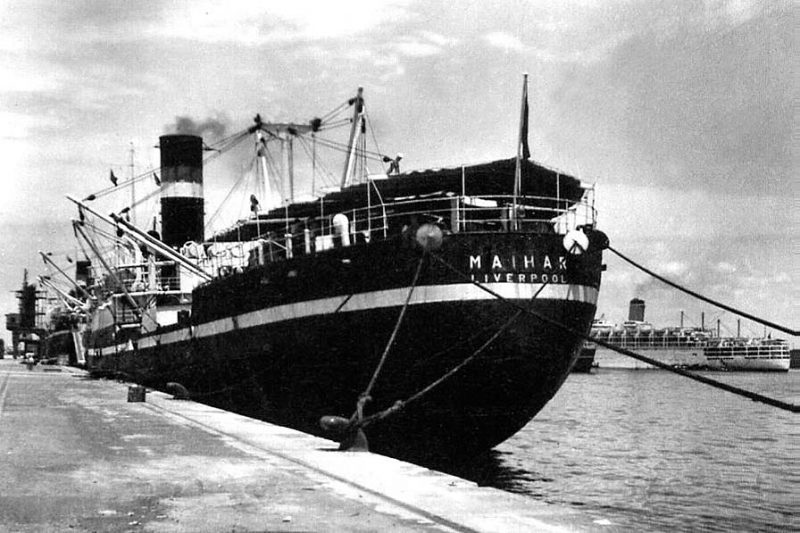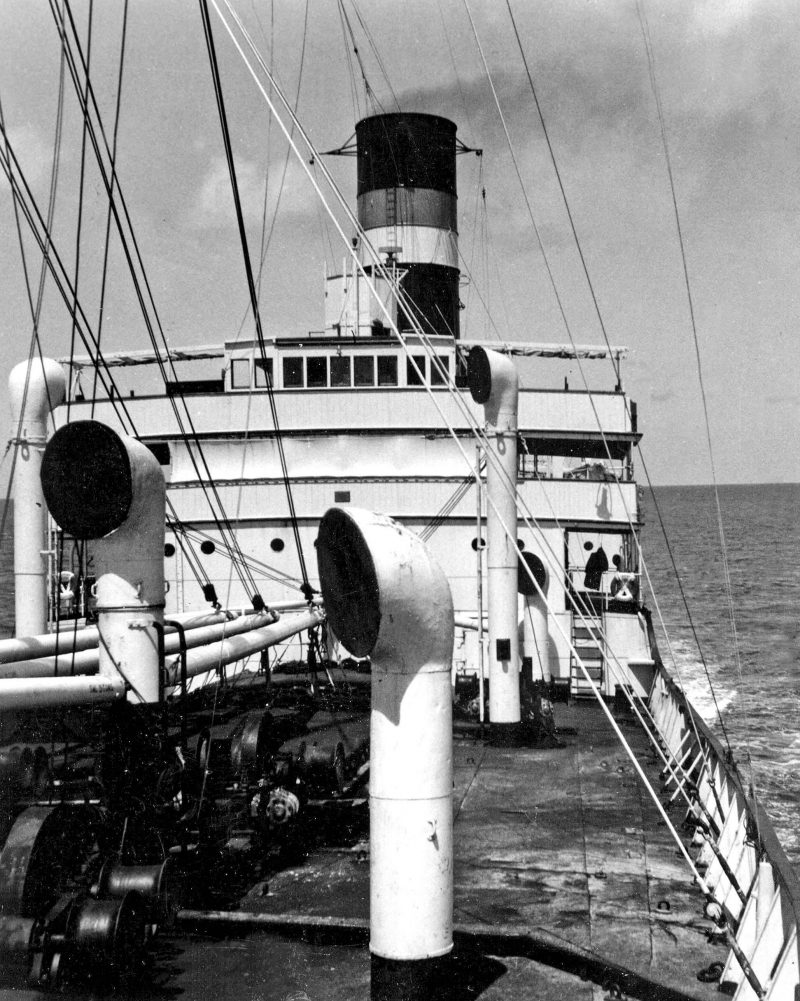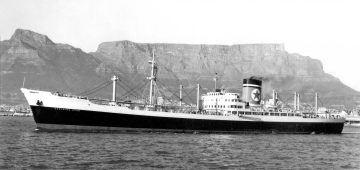To India on SS Maihar – Part one
By Jim Pottinger

 It is only when one studies the present day pattern of seaborne trade and types of ships now employed, that one realises the revolution that has occurred over the past forty years or so.
It is only when one studies the present day pattern of seaborne trade and types of ships now employed, that one realises the revolution that has occurred over the past forty years or so.
Unlike the in-and-out container ships of today, the voyage to India and Pakistan and back on the Maihar in 1957 saw her spend 62 days at sea and almost double that time in port.
At that time it was inconceivable that there would be, for example, no Brocklebank, Holt, Ellerman, Clan or B.I. ships to be found in the ports of the world in fifty years time. These were all household names with a long and honourable history of trading and service in many wars.
My own deep-sea experience during that period included service in a number of ships belonging to Thos. & Jno. Brocklebank Ltd., long established and well regarded shipowners dating from the formation of the company in Liverpool in 1802 with the sailing ship Active.
They were one of the oldest established shipowners in the world whose origins can be traced back to 1770 when Daniel Brocklebank built his first wooden ship in Sheepscott near Portland, New England, having earlier set out from his native Whitehaven in Cumbria to start up a shipyard in the colony. Earlier he had been apprenticed in a shipyard in Whitehaven, where his father was rector.
With the start of the American War of Independence he returned to Whitehaven in the Castor, a ship he captained for a number of years afterwards, until he came ashore in 1785 to found his own shipyard and ropery at Bransby in the port.
Daniel retired in 1800, and the business was then carried on by his sons Thomas and John, the firm becoming Thomas & John Brocklebank, this was shortened to Thos. & Jno. Brocklebank, Jno. being the abbreviation for John at that time.
They built their first ship, the Active, in 1801 and continued a policy of often building on spec and if not sold they ran the ships themselves.
With the expiry of the lease, the yard was closed in 1865, their final ship no. 157 being the Mahanada (1). Many years later a group of ships were ordered they were given ‘M’ names to commemorate this event, and thus the ‘M’ nomenclature was retained until the final days of the company.
The year 1889 saw the arrival of their first steamer, the Ameer, but it was not until 1901 that the last of the sailing ships were disposed of. This was the Holkar which was sold to Germany.
During the period I was in the Merchant Navy breakbulk and general cargo constituted a major part of seaborne trade, although bulk carriers and tankers were gradually increasing in size, the tanker Spyros Niarchos, built by Vickers in 1956, was one of the largest tankers afloat at 47,000 tons deadweight.
Having completed my first deep sea voyage in a ship of a different company, I joined the Maihar in May 1957 while she was lying at the Gyproc Wharf in Glasgow, just around the corner from the KGV Dock which, at that time, was full of Clan, Holt and Shaw Savill ships.
I had joined Brocklebank for the reason of immediate promotion, and the chance to remain on steam ships which I preferred at that time. The company’s fleet was exclusively steam powered, either with turbine or triple expansion reciprocating engines.
The Maihar had been built as far back as 1917 by Russells of Port Glasgow and was a typical vessel of that vintage with straight stem and tall funnel designed to support coal burning combustion. Surprisingly she had a very handsome and shapely cruiser stern in contrast to the counter sterns of some of her contemporaries.
She was 7,563.31 gross tons and 11,214 deadweight tons and was 490.5 feet overall length.
The ship was fitted with a triple expansion reciprocating steam engine built by J. & G. Kincaid of Greenock, taking steam from four Scotch type boilers. These also provided steam for the auxiliaries in the engine room, winches and steering engine on deck.
Seemingly a lucky ship, she entered service at the latter stages of WWI, and continued to sail back and forth from the UK to India with intermediate calls as required in the years between the two wars.
She was still lucky during WW II, apart from some minor mishaps. Lucky that is in comparison to the other 16 ships in the fleet lost due to various causes.
She took part in 5 OS and OS/KMS convoys, with her final destination being Ceylon and the Indian Continent.
OS 14 – depart Liverpool 13/12/41, arr. Freetown 3/1/42
Maihar left the Clyde to Calcutta via Freetown and Cape Town
OS 35 – depart Liverpool 21/7/42, arr. Freetown 10/8/42
Maihar left the Clyde to Colombo via Freetown
OS 45 – depart Liverpool 24/3/43, arr. Freetown 14/4/43
Maihar left Oban to Bombay via Freetown and Karachi.
OS 58/KMS 32 – depart Liverpool 5/11/43, arr. Gibraltar 19/11/43
Maihar left the Clyde to Bombay via Gibraltar
OS 105/KMS 79 – depart Liverpool 17/1/45, separated 22/1/45, convoy dispersed 26/1/45
Maihar left Liverpool to Calcutta via Suez, and Bombay.
She also crossed the Atlantic, and on one memorable occasion she must have pulled up her skirt as she romped through the whole convoy and out of sight.

She had sailed from Taranto after discharging a cargo of coal from Lourenco Marques and joined a convoy going westward, with the intention of calling at Casablanca for sand ballast.
In the event she remained with the convoy and made the Atlantic crossing completely empty, and with only the deep tank filled, in the centre of the convoy, she was rolling and pitching to an extent that suction on the condenser inlet was being frequently lost due to her minimal draught, with consequent loss of vacuum resulting in the engine having to be stopped.
This naturally caused mayhem in the middle of the convoy and the Maihar was then put to the rear of the convoy out of harms way. During one particularly dirty night she stopped several times. With the weather moderating, and under way once again, she set off at full speed in the darkness under the impression that she were far behind the rest of the ships in the convoy.
It was during the 0400-0800 watch that a low shape was spotted, initially thought to be a submarine. However it was a four funnelled ex-US destroyer, and in answer to the query, “how far ahead is the convoy?” the retort was, “you are 8 miles ahead of it, we are the outer forward escort!”
Their true position was revealed in first light when the rest of the ships were approaching from astern.
The Maihar had apparently sailed through the convoy without seeing any ships in the darkness.
Sailing light ship was one of the hazards in winter in wartime. On another occasion the concrete protective slabs bolted to the bridge fell off due to the severe rolling and movement. The whole bridge started to sag behind the roll, and had to be braced with wires and turnbuckles rigged from the foredeck criss-cross fashion over the bridge.
At the time of me joining the Maihar she was in the final stages of a protracted refit by shipbuilders and engineers Alexander Stephen & Co. This work had taken almost eighteen months and was a major refurbishment.
Her original boilers were replaced with new oil fired units, many new pumps were installed and the main components of the engine had been returned to the original builders for overhaul. All the accommodation had been completely renewed to modern standards, the piece-de-resistance being the splendid permanent swimming pool built into the boat deck, not a temporary wooden framed canvas affair but a proper flush pool on the boat deck aft of the funnel. This must have been unique on this class of ship, and I can well remember the looks of astonishment of passengers aboard a liner moored close by at Port Sudan on seeing us running along the boat deck and disappearing from sight in the pool!
All the Engineer Officers were berthed in cabins arranged outboard amidships along the ship’s side, with wide working alleyways inboard. As the sea often swept through these passages, the cabins had heavy weatherproof doors with lighter mosquito proof jalousie doors inside.
The Chief and Second Officer and Chief Steward were berthed in cabins abreast the dining saloon at the forward end of the centre castle, with the Master above under the bridge.
A new officers lounge had been built at the aft end of the centre castle with a two berth cabin for deck apprentices directly above at the after end of the boat deck. As built the Maihar had a break between the after block of accommodation and cabins abreast the funnel, this gap was decked over but a small break was provided outboard on each side to provide space for the oil fuel bunkering valves.
The old radial davits had been replaced by modern gravity type, but the original clinker built wooden lifeboats were retained. They required a good soak for the seams to tighten up each time they were put in the water.
Whilst internally the Maihar was to all intents and purposes a new ship externally her appearance was much as she had always been, her tall funnel gave perfect combustion now assisted by a forced draught fan.
With the reduced engine-room manning as a consequence of change from coal to oil firing, the two lifeboats formerly carried on the bridge were discarded, and the two deckhouses on the aft deck abreast the mainmast were converted into mess rooms for the Asian deck and engine-room ratings, which eased the congestion in the poop accommodation. These deckhouses had apparently been used as chemical stores during the war, and were to be the cause of some embarrassment and consequent legal tangle whilst we were in Colombo during the voyage.
The Fifth Engineer Officer and I had been doing some repairs on a cargo winch on the after deck, and after adjustment it was necessary to give it a try out. To do this the Fifth hoisted and lowered the cargo hook smartly, too smartly as it turned out, as a full sling of bagged cement dropped smack on top of a flimsy trailer on the dockside which was in fact obscured by these deckhouses.
Our repair had taken some time, and during the wait some of the stevedores had taken a nap in the cab of the lorry. They had a very rude awakening and made a startled exit when the weight suddenly dropped on the end of the trailer and tipped it up.
The legal ramifications of this incident dragged on all the while we were in Colombo and the Captain and Fifth had to attend a number of meetings ashore in an effort to reach an amicable settlement.
In the late fifties, it has to be remembered, ships were still in great demand to replace war losses, and shipyards were in the situation where they could literally turn away orders. It therefore made sense for Brocklebank to spend a significant amount in modernising the Maihar as a stopgap until their new ships being built were commissioned.
As I was sailing as Fourth Engineer and this was the first ship I had sole charge of a watch, I utilised the five days available before trials to familiarise myself with the machinery and all the pipelines and systems in the engine and boiler rooms.
The situation aboard was almost complete chaos with the yard staff trying to complete the work before the due date. Swarms of workmen were everywhere, but gradually some order was achieved and we made ready for dock trials.

At the first swing of the engine water sprayed everywhere. Either in haste or ignorance a pipe fitter had led one of the cooling water pipes right across the track of the moving arms of the engine-driven air pump, and once they swung they sliced through the copper pipe with the resultant flood.
After finally making our way down the Clyde to the Tail of the Bank our sea trials took three days owing to continual stoppages due to overheating bearings etc. Once the ship was accepted the river pilot was dropped and we set sail on 30th May 1957 for Middlesborough which was to be our first loading port for the deep sea voyage.
We had not steamed far however, when late on my first night watch, the 2000-midnight, I was aware of a clanking noise coming from the top of the engine. By that time we were prepared for the worst and were apprehensive in case some of the LP piston nuts had worked loose and could damage the cylinder cover. After consultation with the Captain we decided to stop the ship and investigate. All the lagging was taken off and the numerous big nuts around the circumference were loosened and then allowed some of the heat to dissipate before the cylinder top was lifted off. On the Maihar the LP piston was 6ft. 8Ins. in diameter so the cover was a fairly large lump.
It was found that some of the piston junk ring nuts had loosened but luckily no damage had been done. We then lifted on the cover again and flogged up all the nuts. It was then that someone had discovered that their torch was missing, the suspicion being that it had been left inside the cylinder!
There was only one remedy and the whole procedure had to be repeated. Lo and behold when the cover was taken off again there was the torch lying on top of the piston, still lit too!
This emergency stop came just after midnight and as far as we were concerned, after all the trials and tribulations of the past week this was the straw that broke the camel’s back, so after getting everything ready for getting underway again it was decided to drop the anchor for the rest of the night rather than continue.
This was a most welcome break and allowed all the watch-keepers to catch up on some sleep and was much appreciated by the engineers who had borne the brunt of the work.
We spent the night swinging peacefully at anchor in the shadow of Ailsa Craig and got under way again after breakfast, and, apart from a slow down off Lands End due to fog, had an uneventful passage round to Middlesborough.
We loaded cargo for five days there and then we crossed over to Antwerp. Only spending 24 hours there we made the short hop back across the Channel to complete loading at Royal Albert Docks in London.
At that time cargo work was only done during the day in London in contrast to round the clock on the Continent. This certainly put a strain on our elderly cargo winches. These were already showing signs of trouble to come and needed a lot of attention to keep in working order. In fact they were our biggest headache and just could not stand up to the constant hammering. At least in London we were not liable to be called out in the middle of the night to be confronted by the night winch-wallah with a pile of bits from one of the winches.
In port with the main engine shut down we kept only one boiler steaming to supply steam to the winches and other auxiliary machinery. This allowed the Engineering Officers to come off watches and work a day work pattern of 0700-1600 with hour for breakfast and lunch. Routine monitoring of the boiler and other machinery was entrusted to the donkeyman and greaser.
After eight days we completed loading and we undocked and entered the Thames and proceeded down river, dropping the last pilot off Dungeness. We were now on our own and settled down to sea watches uninterrupted by the stoppages and speed alterations associated by coastal passages.
All the officers on the Maihar were British, but following usual company practice, the crew ratings were nationals of India or Pakistan. The officers consisted of, captain, first, second and third deck officers, and chief, second, third, fourth and fifth engineers, a carpenter, two radio officers, chief steward and two deck apprentices.
Brocklebank were unique in that they employed their own radio officers, and not hired from Marconi.
Sea watches were on the usual pattern viz.
| midnight-0400 | 3rd engineer, 2nd mate |
| 0400-0800 | 2nd engineer, 1st mate |
| 0800-noon | 4th engineer, 3rd mate |
| noon-1600 | 3rd engineer, 2nd mate |
| 1600-2000 | 2nd engineer, 1st mate |
| 2000-midnight | 4th engineer, 3rd mate |
This was intended to give a pattern of four hours on, eight off, but in practice various additional duties on deck and in the engine room meant that extra hours had to be worked after the end of the watch.
When entering and leaving port or on long river passages the watches were doubled in the engineroom by each watch keeper doing an additional two hours at the end of the normal watch period thus establishing a six on six off pattern. This additional manpower was necessary to cover during the various alterations of speed and manoeuvring.
One engineer handled the engine controls and the other operated the engine room telegraph and making the appropriate entry in the engine room movement book. On receiving a command from the bridge telegraph on the smaller inside pointer of the engine room telegraph he would answer it by swinging the outside pointer to align with the bridge command which would be repeated by the bridge. In this manner confirmation of all orders would be made, and “slow ahead”, “stop” etc. would be entered in the movement book with the time to the nearest half minute, often with hurried orders, some of which would be logged at the same time.
This movement book was most important and could be crucial at any future court of enquiry subsequent to any collision or other accident.
Due to not having many electrically driven auxiliaries on the ship, no electrician was carried. Any electrical maintenance needed was the responsibility of the 3rd engineer. Luckily with all new wiring there was little demand for his services in contrast with some ships where “field days” were very much the norm for the poor 3rd and most afternoons after coming off watch at 1600 were spent on electrical repairs.
In the engine room the watch keeper engineer was assisted by a Tindal, or charge hand, who with an assistant, looked after the boiler room. That included monitoring the steam pressure, water levels and cleaning the fuel burners. Two greasers in the engine room made up the watch keeping compliment.
As the engine was completely open with no forced lubrication, all oiling had to done by hand and the latter two were kept busy oiling all the engine and shaft bearings and topping up the eccentric rod water cooling troughs. As well as being hand lubricated all bearing and other temperatures had to be gauged by hand as there were no thermocouples on the bearings other sliding surfaces.
Only experience could tell if something was not right, and the senses of smell, touch and hearing were all vital in the operation of triple expansion engines of this type.
The most unnerving task to the newcomer was gaining the knack of swinging your arm in synchronisation with the revolving crankshaft, so as to be able to touch the crank pin surface with your finger to gauge the temperature. As the stroke of the pistons were almost five feet the swing of each crank web coming towards you was fairly intimidating, and any error could result in serious injury.
Different loading conditions and varying density of certain cargoes imposed stresses in the after part of the ship which distorted the alignment of the propeller shaft bearings causing them to overheat. As soon as the outside sea temperature reached the seventies little circulating water cooling was effected and we could easily have fried eggs on the thrust block and shaft bearings.
The Maihar was blessed with the provision of a duty mess so there was no need to get showered and changed into uniform to go into the main saloon during mealtimes in the middle of a watch. However all off duty officers were expected to take meals in the saloon. Some Chief Engineers were especially insistent that his staff dress in the appropriate rig of the day and attend meals in the saloon, long the prerogative of Deck Officers, senior Engineer Officers and passengers.
This was Maihar’s voyage 94, and on this trip she was thought to have as complement the youngest average age in the fleet at 25 years. Many of the officers, including the master and chief engineer, were sailing for the first time in their respective ranks.On slack spells on an engine watch the 5th Eng. Officer and I gradually restored all the beautiful hardwood mounting boards on the gauge panels which had been covered with aluminium non-flam paint at time of overhaul. All the brass work was polished to gleaming splendour.
Our normal speed was only about 10.5 knots reducing in strong headwinds or currents. The engine turned at a leisurely 64 rpm, as far as I can recall she only exceeded that when passing out through the Straits of Gibraltar with a strong following tide and high propeller slip.
The normal pattern when going on watch was to enter the engine room at “one Bell”. That is fifteen minutes before the actual start of the watch having already made an inspection of the steering gear. On arrival in the engine room normal procedure was to make a tour of all the running machinery including checking the shaft bearings and stern gland down in the shaft tunnel. Inspection of the boilers was next and all being well it was time to meet up with the previous watchman to discuss anything of note or have warning of any actual or likely machinery malfunctions before he went topside.
Promptness in relieving the watch was always appreciated, especially out East where the engine room temperature often reached 143 degrees F. Some chatty engineers would stay down for a short while but more often it was a quick dash up to the fresh air and grab a couple of beers which had been cooling nicely in the refrigeration compartment.
We had to resist the urge to drink ice cold water whilst in the engine room whatever the temptation. Traditionally in the engine room we had a special gallon pail of fresh water which had a drinking spout. This was soon lukewarm in any event, so we took our cue from the native crew who only drunk lukewarm tea but never ice water to quench their thirst.
In the tropics it was recommended that we take at least two salt tablets each day to replenish the salt lost in perspiration, and also a Paludrin tablet to ward off malaria. On the Maihar, and our other ships too on this route, it was normal to pour the water out of your shoes and wring out your boiler suit when coming out of the engine room at the end off the watch. Actually the boiler room felt cooler than the engine room due to the circulation of air caused by the upward draught created by the combustion in the furnaces.
As 4th it was my job to attend to all the overhaul and maintenance of all the pumps and do the oil fuel transfers. On a quiet watch it was usually possible to strip down a pump and rebuild it on the next. As most were new it was no big chore and in any case the Maihar chugged away herself with a minimum of fuss.




Comments
Sorry, comments are closed for this item